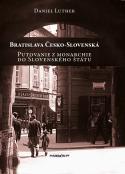Czechoslovak Bratislava. A Journey from the Monarchy to the Slovak State.

- LUTHER, Daniel: Bratislava Česko-Slovenská: putovanie z monarchie do Slovenského štátu. Bratislava: Marenčin PT, 2018. 152 s. Etnologické štúdie 35. ISBN 978-80-569-0146-5
The book is a qualitative contribution to the international research on the origins and on the cultural and historical development of large cities in Central and South-Eastern Europe after the breakup of the Habsburg Monarchy. In his monograph, the author offers a synthesis of the findings from his long-term research on the Slovak metropolis Bratislava with an emphasis on Czech-Slovak relationships in the period 1918–1945. In terms of methodology, he applies combined methods of historical ethnography (archive research) and urban ethnology (qualitative anthropological research).
The author comes to the conclusion that Bratislava’s integration into Czechoslovakia in 1918 meant, to a certain extent, the breaking of ties with the ruling nations of Austria-Hungary. It was a process of large-scale changes in all areas of political, economic, social, and cultural life. In the formerly predominantly German and Hungarian city, changes affected the language system, the symbolism of public spaces, the established practices of its inhabitants, as well as other areas that created the character of the city, thus initiating its systemic “Czechoslovakisation”. In this process, an important role was played by the Czechs who moved to the city in large numbers. They had a strong political and economic background, without which the Slovak community would have had difficulty succeeding within the competitive environment of the city. They also demonstrated their great organisational skills and activity, which the Slovak environment, immobilised by Magyarisation, had not experienced to such a large extent. The author thus explains how firm national awareness and contacts to Czech and Moravian cultural and social institutions allowed for a fast and self-confident formation of Czechoslovak society in the newly established metropolis. The basic framework of the change is well-illustrated by the change of the city’s name – from Hungarian Pozsony or Pressburg to the Czechoslovak and Slovak Bratislava. In addition to observing the general patterns of development of the Central European post-Habsburg metropolis, the author analyses specific social processes that accompanied the gradual mass immigration of thousands of Czechs and Slovaks to Bratislava during the period of the inter-war republic. The publication centres on ethnic interests and conflicts, the formation of inter-ethnic tolerance, the causes and expressions of Czecho-Slovak disputes, and the relocation of Czechs during World War II.
Keywords:
history, nationality, Bratislava